

EMR Market To Witness Significant Growth Through 2021 – 2026. EMR or electronic medical record is the digitized version of paper records that stores all data related to a patient’s care under a particular doctor, such as demographics, progress notes, problems, medications and vital signs, past medical history, immunizations, laboratory data, and radiology reports.
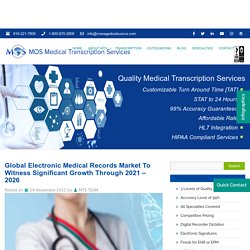
EHR-integrated medical transcription services can help physicians complete their day-to-day documentation tasks easily and thus improve overall clinical productivity. According to a report from Mordor Intelligence, the electronic medical records market is expected to register a CAGR of 7.5 % during the forecast period (2021-2026).The COVID pandemic is putting healthcare systems under strain worldwide and forcing hospitals and other medical facilities to scramble to make sure that data can be shared effectively. How to Use Telehealth to Improve Health Outcomes and Safety. The rapid expansion of telehealth during the pandemic allowed many patients to access healthcare safely, regardless of time or distance.
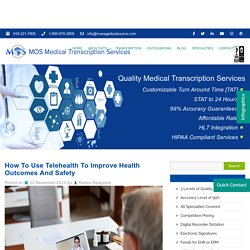
In April 2020, use of telehealth for office visits and outpatient care was 78 times higher than in February 2020, according to McKinsey. Outsourcing medical transcription allows clinicians access to current, accurate information about telehealth encounters. Now that lockdowns have been lifted, patients are returning to in-office visits, but reports indicate that people will continue to use telehealth going forward. Online Transcription Tools Market To Witness Strong Growth By 2026. According to a report from Advance Market Analytics, the online transcription tools market is expected to witness strong growth by 2026.
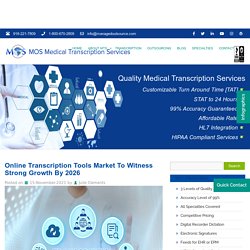
Transcripts of audio/video recordings are important to make text records of almost anything, improve the accessibility of online content, and to maximize SEO efforts. For reliable medical transcription services, most practices either outsource the task or rely on advanced transcription software to get transcripts. When using transcription tools, it is ideal for providers to get the transcripts proofread and edited by experienced transcriptionists. This will improve the accuracy rate. There are a number of real-time transcription apps that can be used easily on phone as well.
How Can A Pain Management Practice Use EHR Correctly? Millions of Americans are affected by chronic and acute pain which interferes with life and work activities.

Electronic health records (EHRs) supported by pain management medical transcription services offer the opportunity to improve care for people suffering from pain by allowing for better documentation, information access, sharing and decision making by healthcare providers and patients. Pain management EHRs are designed to help physicians work more efficiently and effectively, minimize risks, and improve decision making. The software also comes with features that help patients manage their check-in process and work with their physician to manage their care. Using the EHR correctly is a vital element in effectively running a pain management practice and keeping accurate health records to provide proper and timely care, especially for complex and costly patients.
Here are 8 strategies to implement when using EHRs to improve the quality of care in pain management practices: Guidelines To Complete A Transcript Quickly. Medical transcription is one of the most time-saving and essential processes that helps healthcare professionals generate and maintain accurate medical records.
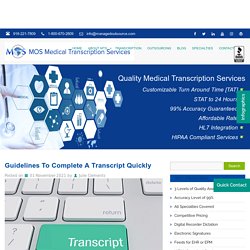
It helps in recording and dictating important notes, generating patient information and securely transforming the recordings into accurate text. A trained and skilled medical transcriptionist converts voice recordings made by physicians or healthcare providers into text format. Some people believe that medical transcriptionists require no particular skill or training. But the fact is that medical transcription requires good training and listening skills, and outsourcing medical transcription is one of the best ways to ensure utmost accuracy in transcripts. The process of medical transcription is a three-level one that includes dictation, recording, and transcribing. EMR vs EHR: What Is The Difference Between EMR And EHR. The terms electronic medical record (EMR) and electronic health record (EHR) are used interchangeably.
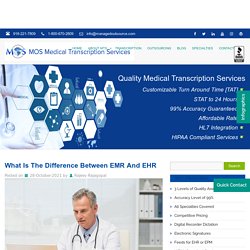
Both store patient data and physicians rely on medical transcription service providers to ensure accurate and timely documentation in these systems. However, while they have other common features, an EHR and an EMR mean different things and serve different purposes. Understanding the differences are between these two types of medical software is important for healthcare providers which application to choose and how it will affect their organization. Electronic Medical Record The Office of the National Coordinator for Health Information Technology (ONC) defines EMRs as digital versions of the paper charts in clinician offices, clinics, and hospitals. What Is The Best Dictation Workflow For Your Needs? Electronic health records (EHRs) contain a wide spectrum of patient information – from patient medical history, diagnoses, medications, treatment plans to immunization dates, allergies, radiology reports, and much more.
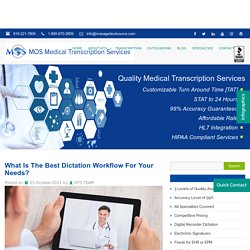
Physicians are not data entry experts and they prefer to dictate medical information. Medical transcription services ensure timely and accurate physician dictated reports. However, there are other ways physician dictation is documented in the EHR, including using specialized software. Medical Transcription Market To Witness Significant Growth By 2025. Medical transcription plays a key role in accurate medical documentation.
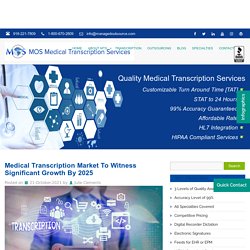
With support from reliable EHR integrated medical transcription services, physicians can save valuable time to focus on providing better patient care. According to a report from Technavio, the medical transcription market has the potential to grow by USD 23.03 billion during 2021-2025, and the market’s growth momentum will slow down at a CAGR of 6.40%. The estimated year-over-year growth rate of 2021 is 8.97%. The industry is also expected to be impacted by the spread of COVID-19 pandemic and predicted to take more than two quarters (six months) to reach a normal state of economic activity. In the short term, the market is expected to show growth due to the increase in infections and reduced economic activity.
How A Medical Transcription Service Can Resolve EHR-Related Problems. Electronic Health Records (EHRs) were introduced with the objective of standardizing patient data and ensuring better access to it.
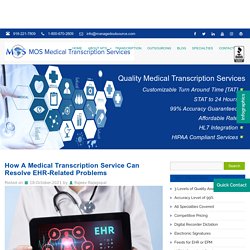
The process of EHR documentation is simple and easy – just click, input data and save. However, in reality, users don’t find EHR documentation quick and easy. With EHR system, physicians are forced to spend their valuable time on the computer capturing patient’s medical information and tend to miss out opportunities to engage with patients during the office visit. Studies have shown that physicians spend one third their time in exam room looking at the computer screen. Medical transcription services are a practical solution to this problem. What Should Be Included In Nursing Documentation? Nurses work demanding shifts and managing documentation can be a phenomenal task.
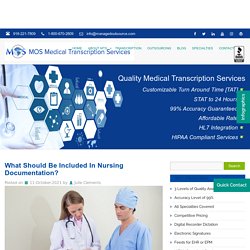
Keeping accurate and timely nursing records is essential for communication among all members of the patient’s healthcare team and to support the delivery of safe, appropriate and continuous care. Good records allow healthcare providers to identify problems and the action taken to correct them. Nursing transcription is a viable strategy to ensure accurate and timely electronic health record (EHR) documentation. How To Use Medical Dictation Software Effectively. Any physician would tell you about the advantages of medical dictation software. Speech-to-text medical dictation software eliminate typing, saves time on clinical notes, improves productivity, and can be accessed from anywhere and reused. Voice recognition software allows providers to record and document interactions with patients on their mobile, laptop or workstation.
There is a wide range of medical dictation software that work on all EHR platforms. Nevertheless, physicians continue to rely on medical transcription services to review and improve the accuracy of speech recognition generated documents. How Can Physicians Save Time On EHR Documentation. Many physicians find electronic health record (EHR) documentation tedious as it involves too much time doing data entry which takes away from direct eye contact with patients.
Physicians need to document each patient interaction correctly and as soon as possible to maintain the integrity of the record. Medical transcription outsourcing is a feasible strategy to create accurate, integrated and complete digital patient medical records from your notes. HIPAA Confidentiality Regulations That Apply To Medical Transcription. The Health Insurance Portability and Accountability Act (HIPAA) sets the standard for protecting sensitive patient data or the confidential use of protected health information (PHI). “Covered entities” or “business associates” that handle PHI are required to be HIPAA-compliant. Covered entities refer to health plans, health care clearinghouses, and health care providers. What Are The Documentation Requirements For ED Reports? Emergency department (ED) documentation is unique because it is the only account of a patient’s ED visit and is completed under strict time constraints. As charting takes away from focus on patient care, physicians can rely on emergency room transcription services to ensure accurate, detailed and timely capture of the patient encounter.
Accurate and thorough patient chart information is crucial for further communication between healthcare professionals involved in patient care in hospital and also upon discharge. Importance Of Proper ED Charting. Guidelines And Tips For Medical Records Management. Consistent, accurate, complete and up-to-date medical records are vital for proper health care delivery and continuity of care, as well as for insurance, legal, and other purposes. The healthcare provider’s responsibility includes manage the records of current patients as well as retaining old records to meet potential needs, and providing HIPAA compliant remote access to patient information by a third party vendor like a medical transcription company.
Basic Functions Of The EHR EHRs contain extensive information generated as a result of patient care: Patient demographicsProgress notesVital signsMedical historiesDiagnosesMedicationsImmunization datesAllergiesRadiology imagesLab and test resultsAdministrative and billing data. Structured Vs Unstructured Radiology Reporting. What Are The 5 Key Rules Of HIPAA? Key Tips to Improve Emergency Department Documentation. How Medical Transcription Services Quicken Pre-hospital PCRs. How to Improve EHR Clinical Documentation and Save Physicians’ Time. Best Approaches for Documenting Allergies in the Electronic Health Record. Can Speech Recognition Support ER Department Documentation Goals.
New Rule Gives Patients Free Electronic Access To Their Medical Notes. Expert Tips to Improve Patient History Taking. Primary Care Physicians to Guide Post COVID -19 Care. Inpatients Face Delays in Endoscopy That Lead to Long Hospital Stay. Key Tips to Write Better Mental Health SOAP Notes. Experts Highlight Pitfalls to Avoid to Succeed with RPM. How Medical Transcription has Evolved Through the Years. 5 Strategies to Partner with Patients and Improve Quality of Care. Recommendations for Documenting an Older Patient’s Medical History. Medical Record Documentation - Take Care to Avoid these Common Errors. Importance of Proofreading and Reviewing SR-Generated EHR Documents.
Some Perspectives on Patient Access to Radiology Reports. Hospital Discharge Summary - Key Components. Importance of Interface between Practice EMR and Pathology LIS. What Are the Different Types of Electronic Healthcare Record Software? Telemedicine and Emergency Care during the COVID-19 Pandemic. Four Common EHR Errors and How to Avoid Them. 6 Common Medical Errors In Healthcare And their Causes. Study Calls for Creating Clear, Patient-friendly Radiology Reports. How to Use the Electronic Health Record Copy-Paste Function Safely. HIPAA Privacy Rule – Proposed Changes and Updates in 2021.
How Medical Transcriptionists Edit Physician Dictated Records. Traits of an Efficient Medical Transcription Company. How to Write Effective SOAP Notes for Physical Therapists. Explore the Top 5 Free Medical Transcription Software 2021. Accurate Physical Therapy Records Vital for Better Profitability. How to Generate Good Clinical Summaries of Office Visits. Best Practices to Avoid Medical Transcription Errors. Get Older Patients Vaccinated to Boost Their Immunity against COVID-19. Maintaining Accurate Electronic Dental Record - Critical Considerations. Top Strategies to Address EHR Usability Challenges.
Solving the Problems Associated with Problem Lists in the EHR. Telehealth a Viable Tool to Combat the Obesity Epidemic. Impact of COVID-19 Pandemic on Demand for Radiology Services. How Clinical Decision Support Tools improve Clinician Efficiency? Top Electronic Health Records Trends for 2021 and Beyond. Write Good and Effective Progress Notes with These Key Tips. Technology can Streamline Data Exchange for Successful Care Transitions. How to Maintain Accurate and Complete Chart Notes in Dentistry. Dos and Don’ts for Telemedicine. Cloud-based EHR Systems for Medical Practices – Key Advantages. 5 Key Considerations for Expanding Telehealth Post-Pandemic. Top Tips for Effective Documentation in Occupational Therapy. Telemedicine Visits – What are the Best Practices?
Medical Transcription Services Market to Reach USD 8176.8 Million by 2026. Telehealth Proving to be a Viable Option for Follow-Up Care. MT Review improves accuracy of SR-generated clinical documents. What are the Five Cs for Quality Radiology Reporting? Telehealth Is Expected to Stay Even after COVID 19. Five Major Challenges facing Healthcare Organizations in 2021. Practices that make a Patient Feel Better after an Operation. Significance of EHR Training to Minimize Physician Burnout. EHRs Need to Adapt to Changing Clinician and Patient Needs. The Rising Use of Teleradiology During the Pandemic. What are the Guidelines to Ensure Quality Radiology Reporting.
Key Tips for a Successful and Stress-free Doctor Visit. Check Out Our Top 10 Blog Posts of the Year 2020. Medical Transcription Software Market to Reach USD 4.89 Billion by 2027. Guidelines and Tips to Write Good Progress Notes. How to Travel Safely without Fears of Covid-19 Dampening the Mood. How to Document the Crucial Components of an Operative Note. Hybrid Model Shaping the Future of Healthcare, say Reports. Quick Tips to Avoid Medication Error and Ensure Patient Safety.
Incomplete Medical Records - Consequences and Solutions. Benefits of Harnessing Telehealth for Chronic Disease Management. Key Components Included in a Hospital Discharge Summary. Physician EHR Documentation Practices can Affect Care. What Are the Different Types of Medical Transcription Reports? Study: Peer Comparisons Can Improve Oncology EHR Documentation. 10 Advantages of EHR Interoperability.
Patient Access to Medical Records Improves Medical Record Accuracy. Reduce EHR Documentation Burden with Scribes & Transcription Services. Seven Things Patients Expect from Medical Practices. Is Telemedicine an Effective Option for Preventive Care? Improving Diagnostic Radiology Report Turnaround Times. Patient Access to Medical Records - Benefits, Barriers and Solutions. Significance of Radiology Transcription for Neurologists and Researchers.
October Is Observed as National Physical Therapy Month.